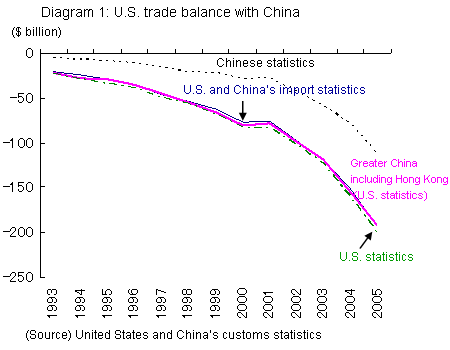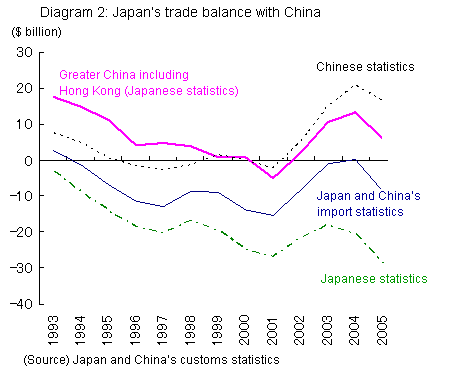Trade friction between China and industrialized nations such as the United States has been worsening in recent years because of widening trade imbalances. However, Chinese statistics show that the nation's trade surplus with the U.S. is roughly just half the figure released by the U.S., and its trade with Japan shows a deficit rather than a surplus. Here, I will clarify the actual state of the U.S.-China and Japan-China trade imbalances taking into consideration transit trade through Hong Kong.
According to U.S. statistics, the U.S. trade deficit with China widened to $201.6 billion ($41.8 billion in exports to, and $243.5 billion in imports from, China) in 2005 from $161.9 billion in 2004. This figure comprises 26.3% of the total U.S. trade deficit ($766.8 billion), and China has for six straight years since 2000 been the largest source of U.S. trade deficit. Meanwhile, Chinese statistics show that its trade surplus with the U.S. in 2005 was $114.2 billion ($162.9 billion in exports and $48.7 billion in imports), much smaller than the U.S. figure.
Theoretically, China's exports to and imports from the U.S. should correspond with U.S. imports from and exports to China, respectively, and China's trade surplus with the U.S. should match the U.S. trade deficit with China. However, while China's exports to the U.S. are much less than U.S. imports from China, its imports from the U.S. are greater than U.S. exports to China. Thus China's trade surplus with the U.S. according to Chinese statistics is not as large as the U.S. trade deficit with China according to U.S. statistics.
A similar statistical mismatch can be seen in Japan-China trade. According to Japanese statistics, the trade balance with its neighbor came to $28.6 billion in 2005: $80.4 billion in exports and $109 billion in imports. In contrast, Chinese statistics show exports to Japan of $84 billion and imports of $100.5 billion a trade balance with Japan $16.5 billion in the red. This shows that Japan and China each logged trade deficits with the other, a phenomenon that may seem contradictory at first glance.
Due to such factors as different calculation methods, a margin of error in the trade statistics of two countries is unavoidable. One reason for this is that customs statistics generally show that figures on the importer's side are larger than those on the exporter's, reflecting the fact that exports are declared on an FOB (free on board) basis, while imports are calculated on a CIF (cost, insurance, freight) basis. However, even this cannot sufficiently explain the extremely large gaps between the statistics of the U.S. and China and of Japan and China.
The key to solving this mystery lies in how trade transiting through Hong Kong is handled. In U.S. and Japanese statistics, a portion of China-bound exports that are shipped through Hong Kong are calculated as exports to Hong Kong, because their final destination of mainland China is not known at the time of export. Meanwhile, imports of Chinese origin through Hong Kong are usually counted as imports from China on the inflow side. In contrast, Chinese statistics count a portion of exports to third countries such as the U.S. and Japan that are shipped through Hong Kong as exports to the special administrative region, because their final destination is unknown at the time of export, but imports from third countries through Hong Kong are all counted as imports from the country of origin.
Based on this, we can assume that the actual scale of trade between the U.S. and China and Japan and China is close to the figures shown in each country's import statistics. If we follow this reasoning, the U.S.-China trade balance in 2005 was the difference between China's imports from the U.S. ($48.7 billion) and the amount the U.S. imports from China ($243.5 billion), and we can estimate that China had a huge trade surplus (the U.S. had a deficit) of $194.8 billion. Similarly, the Japan-China trade balance in 2005 was the difference between China's imports from Japan ($100.5 billion) and Japan's imports from China ($109.0 billion), and while the figure was small, China had a surplus (Japan had a deficit) of $8.5 billion.
In addition to the importance of the trade transiting through Hong Kong, considering that China has resumed sovereignty over Hong Kong since 1997, "Greater China," which includes both the mainland and Hong Kong, would serve as a better reference when considering Japan-China and U.S.-China trade imbalances. In 2005, the U.S. trade deficit with Greater China came to $194.2 billion, not much different from the figure for mainland China alone. Meanwhile, Japan's trade balance with Greater China registered a surplus, albeit small, of $5.9 billion, reflecting the fact that its surplus with Hong Kong was greater than its deficit with mainland China.
Thus both calculations based on import statistics and figures including trade with Hong Kong show that the U.S.-China trade balance swings largely to the black in China's favor, just as indicated by U.S. figures. However, the trade balance between Japan and China is essentially in equilibrium (diagrams 1 and diagrams 2).




